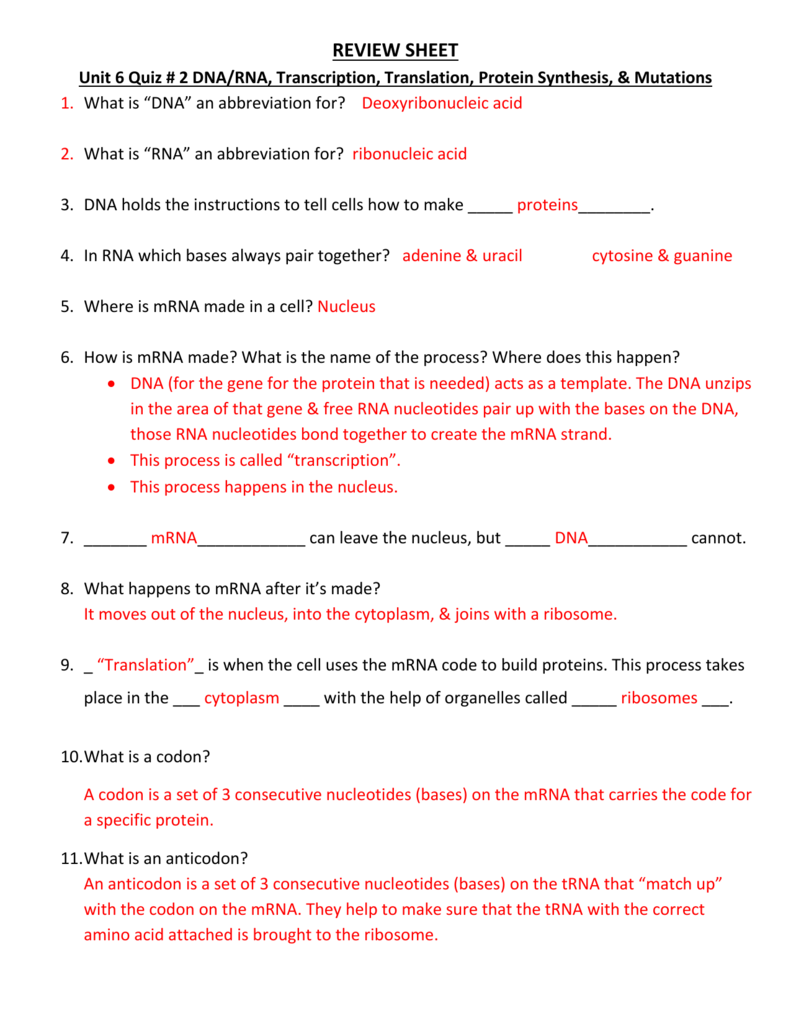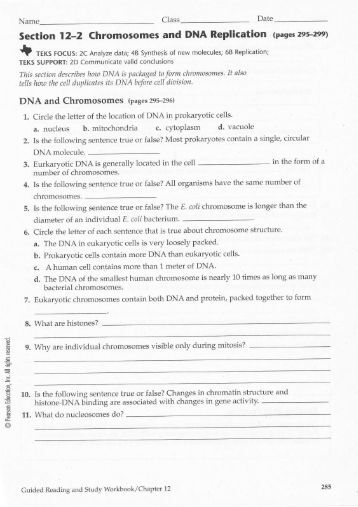39 section 11.2 from dna to protein worksheet answers
PDF CK-12 Biology Quizzes and 11. Science cannot answer all questions. a.The above statement is true because science cannot answer matters of belief. b.The above statement is true because all science is based on logic. c.The above statement is false because science can prove that life evolves over time. RNA Translation worksheet 18 CH 11 section 11.2 - Quizlet DNA Transciption worksheet 17 ch 11 section 11.2 B…. Translation: From RNA to Protien worksheet 18 biol…. Describe the role of an operon in a prokaryotic cell, and give an example of how an operon works. Identify the parts of a prokaryote. Consider Darwin's example of the woodpecker.
11.2 DNA Replication - Microbiology | OpenStax 11.2 DNA Replication - Microbiology | OpenStax Learning Objectives By the end of this section, you will be able to: Explain the meaning of semiconservative DNA replication Explain why DNA replication is bidirectional and includes both a leading and lagging strand Explain why Okazaki fragments are formed

Section 11.2 from dna to protein worksheet answers
Section 11.2: From DNA to Protein Flashcards - Quizlet Start studying Section 11.2: From DNA to Protein. Learn vocabulary, terms, and more with flashcards, games, and other study tools. Home. ... 15 answers. QUESTION. how does a ribosome know what protein to make? 6 answers. ... Ch 11.2 Worksheet. 16 terms. WD55. DNA/RNA Whole Unit. 28 terms. Christina_Isaac. Chapter 13 BIO Quiz. 37 terms. 9.1 The Structure of DNA - Concepts of Biology - 1st Canadian Edition Now let's consider the structure of the two types of nucleic acids, deoxyribonucleic acid (DNA) and ribonucleic acid (RNA). The building blocks of DNA are nucleotides, which are made up of three parts: a deoxyribose (5-carbon sugar), a phosphate group, and a nitrogenous base ( Figure 9.3 ). There are four types of nitrogenous bases in DNA. Transcription and Translation - Cell Biology, Genetics, and ... 11.2 Protein Translation Translation is the process by which mRNAs are converted into protein products through the interactions of mRNA, tRNA, and rRNA. Even before an mRNA is translated, a cell must invest energy to build each of its ribosomes, a complex macromolecule composed of structural and catalytic rRNAs, and many distinct polypeptides.
Section 11.2 from dna to protein worksheet answers. DOCX PC\|MAC What is the name of the molecule that completes the flow of information from DNA to protein? How are the nitrogen bases of RNA different from DNA? List two other ways in which RNA is different from DNA. When you finish your notes, complete this diagram comparing DNA and RNA. RNA DNA DNA and RNA Structure Comparison Double Strand Single Strand Biology 2010 Student Edition - GradeSaver Chapter 11, Introduction to Genetics - 11.1 - The Work of Gregor Mendel - 11.1 Assessment - Page 312: 1c Answer Segregation means that during gamete formation, the alleles of each of the genes separate from one another; therefore, each gamete carries a single allele for each gene. Work Step by Step DNA Transciption worksheet 17 ch 11 section 11.2 Biology Terms in this set (8) How many strands of mRNA are transcribed from the two "unzipped" strands of DNA. One stand. What are the three parts of the RNA nucleotide. Phosphate, ribose sugar, and nitrogen base. How does base paring differ in RNA and DNA. DNA the bases that pair are T-A and G-C. in RNA the bases that pair are U-A and G-C. 15.1 The Genetic Code - Biology for AP® Courses - OpenStax The Central Dogma describes the normal flow of genetic information from DNA to mRNA to protein: DNA in genes specify sequences of mRNA which, in turn, specify amino acid sequences in proteins. The process requires two steps, transcription and translation. During transcription, genes are used to make messenger RNA (mRNA).
9th Grade Biology - Chapter 11 DNA and Genes, 11.1 - DNA: The molecule ... A carbon ring structure that contains one or more atoms of nitrogen Double Helix The shape of DNA because it it is composed of two strands DNA replication The process of making copies of DNA. During replication each strand serves as a patter to make a DNA molecule. Messenger RNA Section 43 46 what are the characteristics of z dna - Course Hero It is the primary component (or constituent) of wood and is the most abundant organic molecule present on the Earth's surface. Section: 11.2 5) Fehling's solution is used to differentiate between reducing and nonreducing sugars. Which type of ion in Fehling's solution allows for this differentiation? Essential Biology 11.2 Muscles and Movement AHL - SlideShare 2. Outline the antagonistic nature of the action of muscles in the human body, using the elbow as an example. 3. Flexing (bending)ExtendingBicepsTriceps. 4. Compare the action of the hip and knee joints. 5. Hip (similar to shoulder)KneeType of jointBall and socketRange of movementBonesLeverFemurFlex/ effortExtend/ effortImage. Biology 2010 Student Edition - GradeSaver Chapter 11, Introduction to Genetics - Assessment - 11.2 Applying Medel's Principles - Understand Key Concepts/Think Critically - Page 332: 8 Answer c. Work Step by Step The physical characteristics that are displayed in an individual is that individual's phenotype. Genetics is the study of heredity, the passing down of traits to descendants.
9.5 How Genes Are Regulated - Concepts of Biology - 1st Canadian Edition For a cell to function properly, necessary proteins must be synthesized at the proper time. All organisms and cells control or regulate the transcription and translation of their DNA into protein. The process of turning on a gene to produce RNA and protein is called gene expression. Whether in a simple unicellular organism or in a complex ... Biology 11.1 - phhscience.weebly.com Chapter 11-2 Chapter 11-3 Chapter 12 Chapter 12-1 Chapter 12-2 ... DNA, RNA, and Protein Formation Series of Videos DNA Lecture 18 Things you should know about genetics What is DNA. DNA Structure. DNA Song DNA Replication Lab DNA Extraction Section 11.1 Quiz Direction for making model Paper for model DNA Lab. DNA Starter Activity: File Size ... PPTX DNA is the only molecule that changes the phenotype ... - KSU | Faculty Web DNA Structure: practice questions. The following comprehension questions (at end of each chapter section) in Brooker, Concepts of Genetics are recommended: Comprehension Questions (at end of each section):11.2, 11.3, 11.3, 11.5 #2, 11.7, Answers to Comprehension Questions are at the very end of every chapter. Answer Key Chapter 2 - Microbiology | OpenStax Introduction; 24.1 Anatomy and Normal Microbiota of the Digestive System; 24.2 Microbial Diseases of the Mouth and Oral Cavity; 24.3 Bacterial Infections of the Gastrointestinal Tract; 24.4 Viral Infections of the Gastrointestinal Tract; 24.5 Protozoan Infections of the Gastrointestinal Tract; 24.6 Helminthic Infections of the Gastrointestinal Tract; Summary
topic 2.7: dna replication, transcription and translation DNA replication is a semi-conservative process, because when a new double-stranded DNA molecule is formed: One strand will be from the original template molecule. One strand will be newly synthesisd. When a cell is preparing to divide, the two strands of the double helix separate. The new strands are used as a guide or template for the creation ...
Mrs. Paul - Biology: AP Biology 2017-2018 - Blogger Read and take notes (on a separate piece of paper) Ch 12.1-12.3, write a summary for each section; DNA Reading with Questions and Coloring; 11/16 Due 11/17: Watch the Bozeman Videos for DNA and RNA (Take 1 and Take 2) and answer the study questions; Create a Venn Diagram to compare and contrast DNA and RNA; 11/17 Due 11/20: DNA Extraction Post Lab
9.3 Transcription - Concepts of Biology - 1st Canadian Edition To do this, the DNA is "read" or transcribed into an mRNA molecule. The mRNA then provides the code to form a protein by a process called translation. Through the processes of transcription and translation, a protein is built with a specific sequence of amino acids that was originally encoded in the DNA.
3.4 Protein Synthesis - Anatomy and Physiology 2e - OpenStax The mechanism by which cells turn the DNA code into a protein product is a two-step process, with an RNA molecule as the intermediate. Figure 3.25 The Genetic Code DNA holds all of the genetic information necessary to build a cell's proteins.
Chapter 11.2 Assessment Flashcards - Quizlet 1.A. What is probability? The likelihood that a particular event will occur. 1.B. How are Punnett squares used to predict the outcomes of genetic crosses? Punnett squares are used to show all of the combinations of alleles that might result from a cross and the likelihood that each might occur. 2.A. What is independent assortment?
DOC Chapter 11 Multiple Choice Practice Test - New Century Academy a. binding induces changes in the cells that lead to cell fusion. b. the cells then produce the a factor and the factor. c. one cell nucleus binds the mating factors and produces a new nucleus in the opposite cell. d. the cell membranes fall apart, releasing the mating factors that lead to new yeast cells. e.
Biology 2010 Student Edition - gradesaver.com Chapter 11, Introduction to Genetics 11.1 - The Work of Gregor Mendel - 11.1 Assessment 11.2 - Applying Medel's Principles - 11.2 Assessment 11.3 - Other Patterns of Inheritance - 11.3 Assessment 11.4 - Meiosis - Analyzing Data 11.4 - Meiosis - 11.4 Assessment Skills Lab - Pre-Lab - Modeling Meiosis
Biology - MY SITE Chapter 2: Glencoe Virtual pH lab. Lab 3: Virtual Macro-molecule Lab . Enzyme Action Lab Directions. Enzyme Action Lab Report Template. Chapter 2 Vocabulary Review Part A (Terms 1-22) Chapter 2 Lab: Enzyme Action (RESULTS INPUT) Bozeman Science Video: Atoms and Molecules. Chapter 2 Vocabulary Review Part B (Terms 23-41) Video: Protein Structure.
Chapter 11, Introduction to Genetics - Assessment - GradeSaver Chapter 11, Introduction to Genetics 11.1 - The Work of Gregor Mendel - 11.1 Assessment 11.2 - Applying Medel's Principles - 11.2 Assessment 11.3 - Other Patterns of Inheritance - 11.3 Assessment 11.4 - Meiosis - Analyzing Data 11.4 - Meiosis - 11.4 Assessment Skills Lab - Pre-Lab - Modeling Meiosis
PDF Protein Synthesis Review Sheets with Keys Date Class Reinforcement and Study Guide Section 11.2 From DNA to Proteih Complete the chart on the three chemical differences between DNA and RNA. 1. strand of nucleotides 2. sugar 3. nitrogenous base In your textbook, read about the genetic code. Complete each statement. 4. Proteins are made up of 5. There are twenty different types of 6.









0 Response to "39 section 11.2 from dna to protein worksheet answers"
Post a Comment